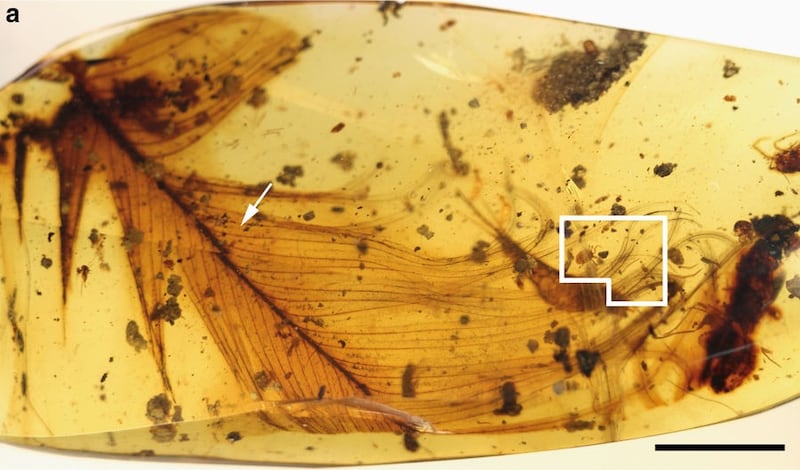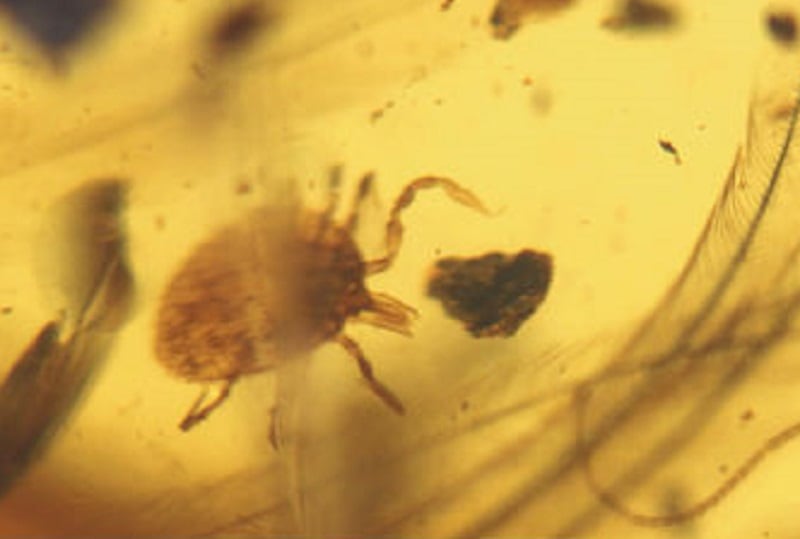Blood-sucking parasites were pestering dinosaurs almost 100 million years ago, scientists have discovered.
Sealed inside an ancient piece of Burmese amber, researchers found a tick still gripping a dinosaur feather after 99 million years.
In an echo of the movie Jurassic Park, another amber fragment contained a tick bloated with what is believed to be dinosaur blood, swelling its size eight times.
This tick and two others trapped together in a third amber piece were assigned to a new extinct group named Deinocroton draculi – which translates as “Dracula’s terrible tick”.

Stephen Spielberg’s movie was based around dinosaurs being resurrected from DNA extracted from mosquitoes trapped in amber.
But there is no chance of the blood-filled tick giving birth to a walking dinosaur.
The scientists behind the new discovery stress that all attempts to remove DNA from such ancient amber specimens have failed due to deterioration of the complex molecule over time.
Ricardo Perez-de-la-Fuente, a member of the international team from Oxford University, said: “The fossil record tells us that feathers like the one we have studied were already present on a wide range of theropod dinosaurs, a group which included ground-running forms without flying ability, as well as bird-like dinosaurs capable of powered flight.
“So although we can’t be sure what kind of dinosaur the tick was feeding on, the mid-Cretaceous age of the Burmese amber confirms that the feather certainly did not belong to a modern bird, as these appeared much later in theropod evolution according to current fossil and molecular evidence.”

The prehistoric ticks look very similar in appearance to modern versions of the blood suckers, which are eight-legged arachnids related to spiders.
The scientists, whose findings are reported in the journal Nature Communications, were not able to identify the host animal whose blood was found in the bloated tick – but indirect evidence points to it being a dinosaur.
Hair-like structures, known as setae, from the larvae of skin beetles were found attached to the two other Deinocroton ticks that were preserved together.
Today, skin beetles feed on shed feathers, skin and hair from birds and mammals. Since no mammal hairs have yet been found in Cretaceous amber, the assumption is that the D. draculi ticks had been feeding on feathered dinosaurs.
“The simultaneous entrapment of two external parasites – the ticks – is extraordinary and can be best explained if they had a nest-inhabiting ecology as some modern ticks do, living in the host’s nest or in their own nest nearby,” said co-author David Grimaldi, from the American Museum of Natural History in New York City.
Amber, often used in jewellery, is fossilised tree resin, the oldest dating back more than 300 million years.
A plethora of ancient insects, spiders, worms, frogs, hair, feathers, wood, fruit and flowers have been found trapped and preserved in amber from the Cretaceous period when dinosaurs roamed the Earth.








